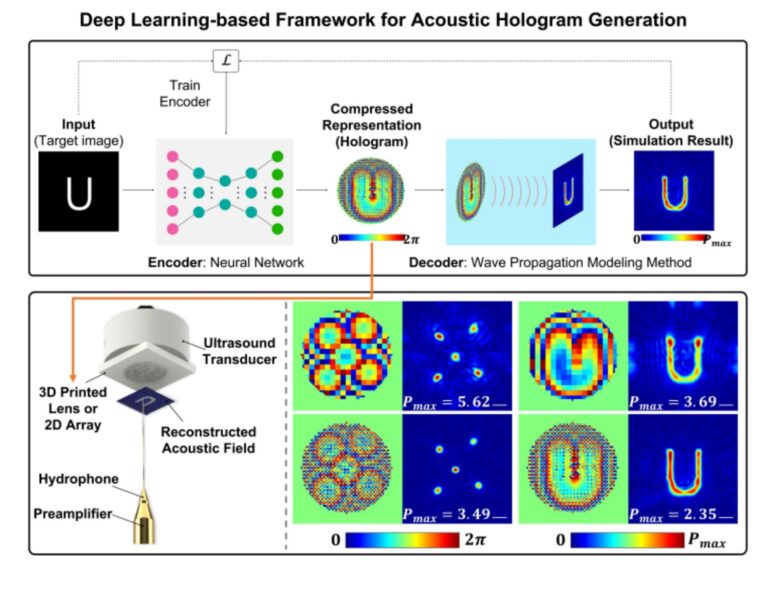TL;DR:
- Professor Hwang Jae-Yoon and his team at DGIST have developed a deep learning-based ultrasonic hologram generating framework.
- The technology enables real-time configuration of focused ultrasound based on holograms, revolutionizing brain stimulation and therapy.
- Ultrasonic brain stimulation shows promise in treating ailments like Alzheimer’s, depression, and pain without surgery.
- The proposed deep learning network allows for precise and rapid ultrasound focusing, outperforming traditional approaches.
- Self-supervised learning and a unique loss function contribute to the framework’s superior capabilities.
- The holographic concept addresses the challenge of selectively activating relevant brain portions.
- This breakthrough promises efficiency in producing acoustic holograms and opens up new applications.
Main AI News:
In a groundbreaking advancement, Professor Hwang Jae-Yoon and his team at DGIST’s Department of Electrical Engineering and Computer Science have achieved a significant milestone by developing a cutting-edge deep learning-based ultrasonic hologram generating framework. This revolutionary technology enables real-time configuration of focused ultrasound based on holograms, unlocking new possibilities for precise brain stimulation and therapy.
Ultrasound has long been recognized as a safe tool, even for prenatal examinations. However, recent research has explored its potential for brain stimulation and therapy, as it can activate deep brain locations without the need for invasive surgery. Conditions like Alzheimer’s disease, depression, and chronic pain can potentially be treated through ultrasonic brain stimulation, as shown by earlier studies.
To overcome the limitations of current ultrasound technology, Professor Hwang Jae-Yoon’s team proposed a novel deep learning-based architecture that achieves free and accurate ultrasound focusing in real-time. This cutting-edge framework has demonstrated the capability to precisely mold ultrasound into the required form, nearly in real-time and up to 400 times faster than conventional ultrasonic hologram generating algorithms.
The core of the study team’s approach lies in self-supervised learning, a technique that enables a computer to autonomously learn and derive rules from data without predefined solutions. By applying this method, the team developed an efficient deep learning network tailored for creating ultrasonic holograms and a new loss function. The reliability and superiority of each element were validated through meticulous simulations and real-world trials.
The primary challenge addressed by this groundbreaking technology was the limitations of current ultrasound concentration methods, which either focused ultrasound into a single tiny point or a large circle for stimulation. This approach made it difficult to selectively activate specific brain areas when multiple regions interact simultaneously. The team’s solution came in the form of a holographic concept that enables the flexible and precise focus of ultrasound on specific brain locations.
Traditional acoustic hologram algorithms have been a stepping stone, but their efficiency in producing acoustic holograms quickly and accurately remained a concern, hindering the exploration of new applications. DGIST’s Professor Hwang Jae-Yoon and his team have now ushered in a new era with their deep learning-based system, delivering rapid and accurate creation of acoustic holograms. The framework’s unique autoencoder-like design facilitates unsupervised training, eliminating the need for ground truth data. The holographic ultrasonic generating network (HU-Net), a cutting-edge hologram generator network optimized for unsupervised learning, along with an energy-efficient loss function designed for holograms, has been successfully showcased within the framework.
Conclusion:
DGIST’s deep learning-based acoustic hologram generation holds significant potential for the market. With its ability to revolutionize brain stimulation and therapy, it offers a safer and more efficient alternative to traditional methods. The technology’s applications in treating neurological conditions and enhancing precision will undoubtedly attract interest from medical and research communities. Moreover, its potential for new applications beyond brain stimulation opens up opportunities for diverse industries. As this technology matures and gains wider adoption, it could become a game-changer, setting new standards for the acoustic holography market. Businesses in the medical and technology sectors should closely monitor its developments to stay at the forefront of this transformative innovation.

